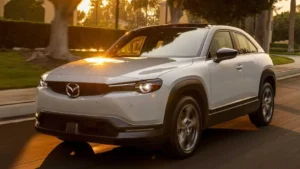The MX-30 crossover, Mazda’s entry into the U.S. electric vehicle (EV) market, has proven to be a difficult lesson. The model’s time in America was brief, selling only 100 units in the first eight months of 2023 and being constrained by a 100-mile range. While it may be easy to view this as a setback, Mazda’s upcoming actions show a company that is eager to adapt and find its own position in the burgeoning EV industry.
Mazda is looking to find a segment that appeals to all EV enthusiasts
Mazda plans to introduce more electric vehicles in the United States in 2025 after the MX-30’s success on the market. Mazda is moving toward a cost-effective strategy—using common platforms with its existing gasoline-powered vehicles—instead of creating a separate EV-dedicated platform like GM and Volkswagen. This strategy not only saves money but also provides an interesting test of how customers will react to such a fusion of the old and modern.

However, there are several disadvantages to the common platform model. One is being ineligible for the $7,500 maximum federal EV tax credit in the United States, which is contingent on final assembly in North America. Although it is a challenge, Mazda is certain that their planned electric SUVs will still be appealing to American consumers even without the government problems.
Masahiro Moro, chief executive officer of Mazda, succinctly put it this way: “We are looking at a segment that will appeal to would-be EV buyers.” This suggests a shift away from compact electric vehicles like the MX-30 and toward possibly more lucrative, bigger automobiles, most likely SUVs given their widespread appeal. One might have to wait a little longer for an electric Mazda MX-5 sports vehicle.
